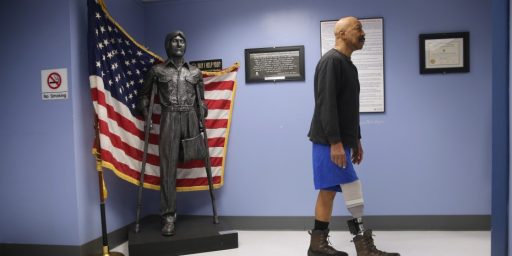VETERANS PENSIONS
Senate Democrats plan to join Republicans in approving a $401.3 billion defense bill despite provisions they said would erode the rights of civilian defense employees and weaken environmental laws.
They noted the measure authorizing 2004 defense programs would also raise salaries for soldiers by an average of 4.15 percent and extend increases in combat and family separation pay.
The Senate was expected to approve the bill Wednesday and send it to President Bush for his signature.
“Our men and women in uniform will at least have some peace of mind that while they’re facing imminent danger, while they are separated from their families, we are going to give them some additional assistance,” Sen. Dick Durbin, D-Ill., said Tuesday.
The bill would also partially reverse a policy set in the 1890s of reducing disabled veterans’ retirement benefits by $1 for every dollar received in disability pay. The change would be phased in over 10 years and mainly help the more seriously disabled–about a quarter-million veterans. It will cost $22 billion.
$401.3 billion qualifies as real money. Indeed, it’s easily more than the combined defense spending of the rest of the planet. I’m not sure why disability payments to people who haven’t been in the military in decades should come out of the defense budget; that’s not money that goes to defending the country. That should come out of the Department of Veterans’ Affairs, which should be a totally different budget. I’m curious as to how much of the $401.3B is devoted to similar, non-defense, items.
The “offset” has always been a rather strange concept, and one not well understood. Most people think of disabled veterans being people like Bob Dole or Max Cleland, who were seriously wounded in combat and continue to suffer the effects of those wounds. But most disabled vets are people who suffer ordinary injuries or degeneration either while in uniform or in some other way tracable to their time in the service. This includes people who are injured in automobile accidents while on leave, for example.
One can suffer such an injury, document it with the Department of Veterans’ Affairs, and get a lifetime tax-free payment from the government. The payment is a flat fee–regardless of rank or time in service–adjusted based on percentage of disability. So, if one is determined “30% disabled,” the payment is 30% of the current maximum ($2193 at present). So, an 18-year-old private who ruins his knee while waterskiing* gets disability benefits for life.
Now, if someone spends 20-plus years in the service, they draw a pension. The amounts have varied over time but my understanding is that we’re now back to the long-time system where retirees get 50% of their base pay for 20 years of service plus an additional 2.5% for every year thereafter up to a maximum 75%. Upon retirement, one can also claim any injuries that have mounted up over those years of service and get declared partially (or completely) disabled. Those benefits are calculated exactly as if the service member had been in for a few weeks. The catch is that any disability benefits awarded are subtracted dollar-for-dollar from the pension. So, while the kid who ruined his knee water skiing gets full benefits, the 40-year-old who ruined his knee from a career of jumping out of a C-130 (while in flight) with a 150-pound ruck gets, essentially, squat. The only real advantage to the VA disability pay is that it is tax-free, while the pension may or may not be tax free, depending on the state in which one lives.
Update (1256): *I don’t mean to trivialize disabilities with this example. Certainly, we have soldiers injured while undergoing serious training–helicopter crashes, having an APC roll over their leg whilst sleeping, etc. I merely note that the nature and circumstances of the injury are irrelevant, with the exception of injuries while committing crimes.






James, you glossed over the fairness issue of the offset, though. I am an Army retiree with a disability rating, for which the VA pays me a monthly disability allowance.
But, as your cited article notes, my retirement pension is reduced by exactly the same amount. In other words, the government is basically counting my disability as “bad time” and not permitting it to be counted toward retirement.
The VA disability allowance is compensation for the injury. It is intended to partially offset my future lost earnings incurred because of the disability.
But the offset is punishment for the injury. My net compensation, then, is zero, unless you count the very tiny tax advantage I gain because the disability allowance is untaxed.
Bottom line: the offset taxes disabled retirees for being disabled. It is in truth a tax on the disabled. Nota bene: civilian federal retirees who receive a disability allowance are not offset; they receive the disability and full pension. But military retirees just get screwed.
Donald:
Right. My dad is one of those impacted this way: A 20-year Army NCO (retired 1SG/E-8) who is, I think, 40 percent disabled. It’s a pretty raw deal.
I think there is just a general feeling that retirees already get an unfair deal, since most people can’t retire after 20 years. But, as you well know, not too many soldiers can pull that off, either. Plus, there is the presumption that, if you were able to pull 20 years of duty in the military, you must therefore be fit. That’s not necessarily true, either but it’s one of the strange Catch-22s of military life: You’re not allowed to be sick or injured while you’re on active duty, but you can suddenly become disabled upon putting in your retirement papers.
—